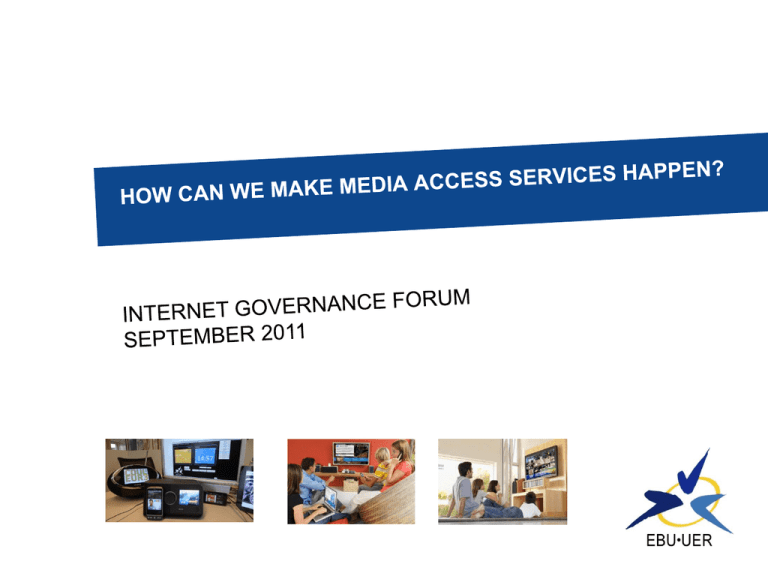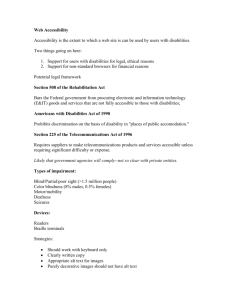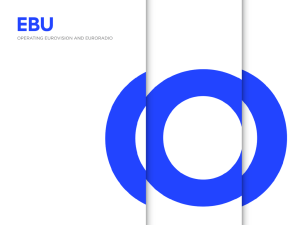Document 12952075
advertisement

Finance Management awareness of need and value Audience measurement tools Skill set by creative staff Equipment availability for production and delivery Lack of unique worldwide standards Lack of benchmarks of ‘goodness’. Broadcasters today are faced with ever diminishing incomes. Somehow, someway, everything has to be paid for. PSM Broadcasters have to make difficult choices about how best to meet their public services obligations. Should they better serve ethnic minorities, minorities with disabilities, or others? What do you think? Estimates about how much extra cost is incurred by including access services are wildly different – they are as much as ten to one different. It may depend on how much you want or don’t want the bother of providing them? How can we get to the bottom/truth of this? For most managers in the media, access services for those with disabilities is completely ‘off their radar screen’. Managers are concerned with short term survival. ‘Where will I find the money for my next production’ is the important issue for them. The longer term, or ways of helping society, are usually put on the agenda of the ‘next’ meeting . How can we change this? Who can change this? It’s hard to know how many people use access services when they are provided. Its hard to know how much value they are More information is becoming available about which services are the most valuable and most used from Projects like DTV4ALL. More thought is needed about easy and simple monitoring of use. This should be very easy to devise with web delivered services – we can know who watches what, when and for how long. It’s not ‘a piece of cake’ to provide ‘good’ access services. Staff need to know how to construct sub-titles, particularly those that describe action in the screen. There is an ‘art’ in preparing good audio descriptions. They need skills like unobtrusive intonation, concise and imaginative scene description capability. Each must work in the national language concerned. Staff need training and there are few, if any, national language training schools. Could we get someone to start one up? In some countries there is training available, but its by no means universal.. Equipment availability The manufacturing community is moving forward with including features for those with disabilities in receivers. Globally, this is painfully slow. One of the problems is that if you introduce features for those with disabilities in a new set, what do you do for the millions of those with disabilities who have the older models without the features? Should governments make receivers with features for those with disabilities free of charge? If so, who would pay for them? It is simple economics of scale to see that the more people that use the same standard, the cheaper will be the system. Yet the different developed countries perpetually develop their own systems. How can we change this? Can the new ITU Focus Group help? We hope so. No one has any really good idea of what constitutes ‘enough’ access services. A few countries have national quotas for subtitling and audio descriptions, but only a few. The UN Resolution on the Rights of Persons with Disabilities is vague and unclear about what are ‘reasonable measures’. The ITU may be able to help with guidelines for interpreting the Resolution. Let’s encourage them to do so. The European Commission is mapping their Audiovisual Media Services Directive against the UN Convention. This way they can be more specific in their dealings with national legislation. Maybe the biggest hope for the future of access services lies with hybrid systems. This will help with the flexibility of subtitles and get around the bandwidth problems for opt-in visual signing. The basics of subtitling and audio description are already in place in DVB standards. The TV or radio receiving system remains the same, but the TV set or radio set includes internet connectivity. If the access services are now provided by the broadband web, no new or additional, or unusual, equipment is needed. The same equipment is needed for everyone, with or without disabilities. Hybrid Television. Media content from broadcast and broadband can be combined on the same screen, or the display can display separate content from either. The Two Screen television experience. The viewer who wants and needs it can watch independent services on a laptop, tablet, or smart phone. Hybrid Radio. Radio sets that are so equipped can readily hop to web content about the radio show, and the two can be a combined experience. The new ITU-T Focus Group has a large and important task, and needs much support and encouragement. There are many barriers to be overcome before we see the kind of access services that those with disabilities deserve widely available. One of the brightest hopes is to make use of hybrid technologies..but how long will it be before they are widely available, and will the great fragmentation of standards and systems hold back their success?




